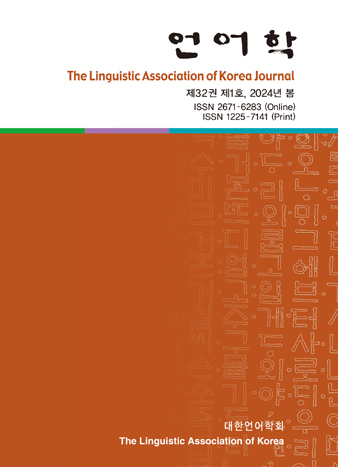대한언어학회 전자저널

32권 1호 (2024년 3월)
- Adaptation of the English Agentive Suffix in Korean: An Optimality-Theoretic Analysis
-
Youngyoon Cho · Hongwon Seo
Pages : 157-169
Abstract
Cho, Youngyoon & Seo, Hongwon. (2024). Adaptation of the English agentive suffix in Korean: An optimality-theoretic analysis. The Linguistic Association of Korea Journal, 32(1), 157-169. This research explores the morphological and phonological adaptation of the English agentive suffix '-er' into Korean, employing the framework of Optimality Theory (OT) by proposing a revised constraint hierarchy that accurately captures these processes. Through a comprehensive examination, two pivotal constraints, *NON-MORAIC-l and IDENT-IO (manner), were identified as central to addressing previous analytical shortcomings. The refined constraint hierarchy-comprising ALIGN-STEM-R, ALIGN-SUFFIX-L, *NON-MORAIC-l, SYLLCON, and IDENT-IO (manner, place)-offers a distinct explanation for the selection of optimal candidates in the adaptation process. This work not only deepens the understanding of phonological adaptation processes but also emphasizes the importance of adapting constraint hierarchies to accommodate empirical data, setting a foundation for future research in the field.
Keywords
# adaptation # English agentive suffix # lexical stratum # allomorphs # optimality theory
References
- Asher, R. E. (1994). The Encyclopedia of Language and Linguistics. Pergamon Press.
- Bae, J. C. 1996. An Introduction to Korean Phonology. Seoul: Shingu Publishing Company.
- Davis, S., & Shin, S. (1999). The syllable contact constraint in Korean: An optimality-theoretic analysis. Journal of East Asian Linguistics, 8, 285-312.
- Hogg, R., & McCully, C. B. (1987). Metrical Phonology: a course book. Cambridge: Cambridge University Press.
- Kager, R. (1999). Optimality Theory. Cambridge University Press.
- Kiparsky, P. (1979). Metrical structure assignment is cyclic, Linguistic Inquiry, 10, 421-41.
- Kiparsky, P. (1982). From cyclic phonology to lexical phonology. In Harry van der Hulst and Norval Smith (eds.). The Structure of Phonological Representations. Dordrecht: Foris.
- Lee, D. (2017). Allomorphic variation of English noun derivational suffix \'er\' in Korean: An optimality theoretic approach. Studies in Phonetics, Phonology and Morphology, 23(3), 413-430.
- Lee, S. (2018). A study of manner assimilation: focusing on word-initial [l]-avoidance, lateralization, and nasalization in Korean. Linguistic Research, 35(2), 357-379.
- Lee, Y. (2001). A Moraic Account of Liquid Alternation in Korean. Rutgers Optimality Archive 486.
- McCarthy, J. J., & Prince, A. (1995). Faithfulness and Reduplicative Identity. ms, University of Massachusetts, Amherst and Rutgers University. [ROA-60].
- Mohanan, K. P. (1982). The Theory of Lexical Phonology. PhD Dissertation. MIT. Prince, A., & Smolensky, P. (1993). Optimality Theory: Constraint Interaction in Generative Grammar. RuCCS Technical Report 2, Rutgers University, Piscateway, NJ: Rutgers University Center for Cognitive Science. Revised version published 2004 by Blackwell.
- Prince, A., & Smolensky, P. (2004). Optimality Theory: Constraint Interaction in Generative Grammar. Blackwell.
- Sohn, H. M. (1999). The Korean Language: Cambridge: Cambridge University Press.
- Steriade, D. (1982). Greek Prosodies and the Nature of Syllabification, Ph.D. dissertation, MIT, Cambridge, Massachusetts.
- Selkirk, E. O. (1984). On the Major Class Features and Syllable Theory, in M. Aronoff and R. Oehrle (eds.). Language Sound Structure (pp. 107-36): MIT Press.
- Vennemann, T. (1972). On the Theory of Syllabic Phonology. Linguistische Berichte, 18, 1-18.
- Vennemann, T. (1988). Preference Laws for Syllable Structure, Mouton.